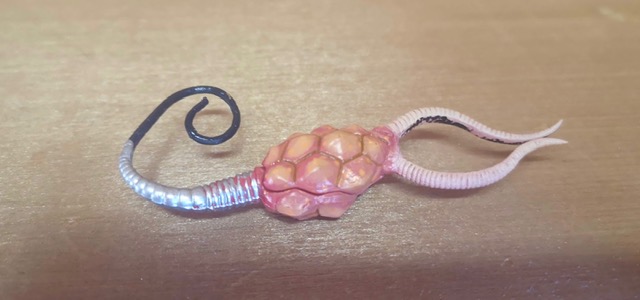Review and photos by Charles Peckham, edited by Suspsy
How does Kaiyodo find new animals to make toys of? Much of their Dinotales series consists of strange and obscure animals that even a seasoned paleontologist might not have come across before. Case in point: Pleurocystites, an echinoderm from the Late Ordovician. Even trying to describe this one is a challenge. Researching for this review from easy-to-digest sources like Wikipedia turned up largely fruitless, and I’ve been doing my best to slough through scholarly journals, which is not my strong suit.

These little guys had two arm-like appendages for catching and eating food particles suspended in the water. They probably sat on the bottom of shallow sea floors, sometimes covering themselves slightly in mud. They also had a flagella-like stem that they probably used mostly to anchor themselves into the mud, but they might have been able to kind of swim around with it too. And they had crystal-like bodies made up of angular bumps (or rhombs). If you would like to learn more about Pleurocystites, I wish you luck.

The Dinotales Pleurocystites is made to fit in a capsule. If you were to buy one unopened, you would, I presume, get all the stuff that it came with on eBay. To wit, a leaflet with some information about the other toys available in the Dinotales line, some instructions for anyone baffled by the two connecting parts of the toy, and another small leaflet with some information in Japanese. My Japanese is a little rusty but I think it’s a warning about a choking hazard or something similar.

The two sections of the Pleurocystites interlock in a way that works quite nicely. The rhombs of its body allow the seams between the two parts to be hidden quite well. The position of the animal seems a little strange to me, and at first (since this was my introduction to the genus), I had difficulty knowing if Pleurocystites were symmetrical or asymmetrical. It appears that they were the former, more or less. The stem is coiled to one side in this figure, though I’m not sure that is how it would have typically positioned its stem in real life. This figure is about five centimeters long, making it one of the few toys on this blog that is actually larger, not smaller, than the animal was in real life.

The paint job isn’t flashy, but it fits very nicely. It really provides insight into the nature of the animal and how it might have looked in life. The shading on the rhombs is quite nice, and it really does a good job of recreating the color variation we see on individual animals in real life. The metallic silver of the upper stem, however, detracts from the sensation of seeing a real animal. It’s like they decided the Pleurocystites needed a suit of armor but then changed their mind after completing the upper stem.
I’m not overwhelmed by the toy. It is kind of interesting, but it doesn’t make me immediately desperate to know more and wish I could see the animal in life. If you have your heart set on getting a toy Pleurocystites, you probably won’t get another chance. Otherwise, I’d say this toy is cool, but not a must have. It goes without saying that unless you have access to a gashapon depository, eBay is your best bet for picking this one up.
Support the Dinosaur Toy Blog by making dino-purchases through these links to Ebay and Amazon. Disclaimer: links to Ebay.com and Amazon.com on the The Dinosaur Toy Blog are often affiliate links, when you make purchases through these links we may make a commission

It’s always good to see another Kaiyodo Dinotales review. There are quite a few still in need of one. It makes me feel like I need to beef up my own Kaiyodo collection, which I hate to admit is pretty small. This thing looks like some sort of Xenomorph life stage. Like an undeveloped face hugger.
Nice review.
I’ve got this one in a display case full of small models in individual cubicles; have spend hours staring at it.
My speculation, for whatever it might be worth, is that this critter functioned a bit like a modern seahorse, clinging to small vegetation in shallow water with its tail, nibbling on whatever passed by.
Cheers.
I’m a big fan of this figure, and more generally of prehistoric seafloor organisms, if for no other reason than that they make a marine diorama more complete. I really like Paleozoic echinoderms because they’re so bizarre, for example in their breaking of bilateral symmetry.
It is a figure, perhaps one of the most fantastically well made by that company that collects prehistoric animals for adults. Magnificent work by Dinotales and magnificent article. Dinotales de Kaiyodo focuses on very obscures figures that is something that we have to thank that great Japanese company. Perhaps the best Japanese company on the market, surpassing even Kinto Favorite.
This is definitely one of the most unusual creatures to turn up on the DTB!